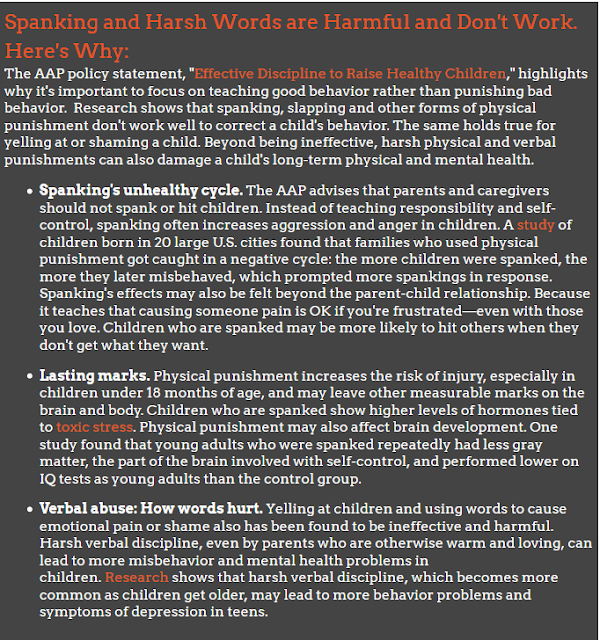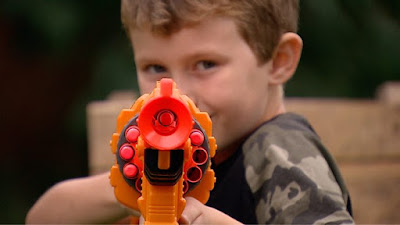Avoiding Harsh Discipline
In a recent policy
statement titled, “Effective Discipline to Raise Healthy Children,” the American
Academy of Pediatrics recommended that parents use positive discipline
strategies to teach good behavior instead of punishing bad behavior. They condoned
the use of harsh disciplines such as physical punishment and verbal abuse as
research shows it does more harm than good.
Image courtesy of “What’s
the Best Way to Discipline My Child?” (2018)
Never Use Physical
Punishment
The
American Academy of Child and Adolescent Psychiatry defines physical punishment
as “anything [that is] done to cause pain or discomfort in response to your
child’s behaviors” (2019). This includes: spanking, hitting, slapping,
pinching, and forcing the ingestion of unpleasant substances such as soap and
hot sauce.
According
to Steinberg (2004), “physical punishment is no more effective than other types
of punishment – in fact, in many situations, it is less effective – and it has
been proven to have a harmful effect on children’s development” (p. 149).
Physical punishment creates excessive aggression in children and teaches them
it is okay to inflict pain on others when they are frustrated and that hitting
can solve problems.
“Physical
punishment is also a poor choice because it can easily escalate out of control
and cause serious injury to the child” (Steinberg, 2004, p.150). The injury
most likely won’t be intentional, it is easy to lose control of your anger once
you start spanking and often parents are unaware of their own strength. If you
spank your child it is not a matter of if they will get hurt, it is a matter of
when will they get hurt. Why participate in such a risky behavior when there
are so many other more effective ways to punish?
Instead
of resorting to spanking, Steinberg (2004) suggests telling your child you are
disappointed in their behavior, putting a young child in time-out, and
depriving an older child of something they want or enjoy. You might just find
they yield the same results without all the negative side effects.
Don’t Be Verbally Abusive
“Like
physical punishment, speaking to your child in an excessively angry or cruel
way has side effects that over time will adversely affect his development”
(Steinberg, 2004, p.150). Parents should avoid using name-calling, sarcasm,
humiliation, and accusations when handing out punishments. Berating your child
or driving them to tears will not get your point across any quicker nor make it
any clearer.
Verbal
discipline has proven to be ineffective for two reasons. “First, your success
as a parent depends in part on the degree to which your child believes that you
have his best interest at heart” (Steinberg, 2004, p. 151). The more you tear
your child down the less he will care about your opinion of him. Without an
emotional relationship, your parenting is ineffective. The second reason has to
do with how the content of the message is delivered. “If delivered in an
especially angry way, your child’s attention will be drawn to the tone of the
message rather than to the real substance of what you are trying to get across”
(Steinberg, 2004, p. 151). Screaming and shouting make it impossible for your
child to focus on your message. In the end, all he will remember is that you
yelled at him and not why he shouldn’t repeat his behavior.
Here
are a few helpful tips to avoid harsh discipline. Focus your remarks on what
your child did and not who he is. Focus your remarks on a specific behavior and
avoid making sweeping generalizations. Avoid attacking their competence,
personality, morals, and future potential. Think about what you are going to
say before you say it. Take a deep breath and choose your words carefully
(Steinberg, 2004, p. 153).
Controlling Your Anger
“Never
discipline your child when you are angry. It only increases the chance that you
will be excessively harsh, either physically or verbally” (Steinberg, 2004, p.
153).
We’ve all had moments when we wanted to yell, scream, or throw something at a coworker but didn’t. Instead, we controlled our anger and handled the situation in a more civil or refined way. We must do the same thing when it comes to disciplining our children. If you find yourself getting angry over something they have done, Steinberg (2004) suggests you take a deep breath and count to three, ten, or whatever it takes to be able to say in a firm yet controlled tone that you are furious with them. Then wait until you are calm to address the situation. The goal is to have your child associate your anger over their misbehavior with an unpleasant consequence but not for that consequence to be a physical punishment or verbal assault.
The Right Way to Punish
Now
that you know what not to do when it comes to punishing, you may be wondering what
to do instead. According to Steinberg (2004), effective punishment includes the
following five elements or steps:
1. An identification of the specific
act that was wrong.
2. A statement describing the impact
of the misbehavior.
3. A suggestion for one or more
alternatives to the undesirable behavior.
4. A clear statement of what the
punishment is going to be.
5.
A statement of your expectations that your child will do better the next time. (p.
156)
The
goal is to do all five steps every time you punish your child.
As
part of an assignment, I had the opportunity to practice these steps. We were
given a choice of three parenting scenarios and then asked to create a dialogue
of how we would respond. I chose the following scenario:
Your
four-year-old daughter is crying about her clothes for the preschool valentine
party. She wants to wear her pants with the hearts on them, but she also wants
to wear her favorite skirt over them (which makes it hard to see the hearts).
You tell her that she can take the skirt off so she can see the hearts, but she
SCREAMS that she wants to wear the skirt. You tell her, “That’s fine, wear the
skirt,” but she SCREAMS that she can’t see the hearts. While she is throwing a
tantrum, she shouts this to you: “I don’t like you! Nobody likes you! Not even
your own mother likes you!” (BYUI FAML 120)
Here
was my response:
I know you are excited about your Valentine’s party
and are trying to put together the perfect outfit. It must be frustrating that
things aren’t working out the way you’d like them to. However, it is not okay
to yell and scream. Or say mean things to me. (Identification)
When you yell and scream, it makes it hard for me to
help you. I can’t understand what the problem is or what you need. When you
tell me you don’t like me, it hurts my feelings, and I don’t want to help you. (impact)
Now, you can choose to wear your heart pants with your
favorite shirt. Or you can wear your favorite skirt with this heart shirt and
leggings. (alternative)
I am going to set the timer for 4 minutes. I want you
to sit here and think about what you said and how you will talk to me next time
you are frustrated. When the timer goes off, I’d like you to pick one of these
outfits and get dressed. After you come out and apologize to me, I will take
you to your party. (punishment)
You are good and putting together your outfits. Next
time you find yourself getting frustrated because things aren’t looking just
right, use your words; ask for help. (expectation) (McDonald,
2019)
Although
I had an easy time coming up with a response, it will take practice before I
can successfully implement this style of punishment. I need to remember to stay
calm and have patience when my child is in the middle of a meltdown. Maybe then
I would have enough wits about me to talk it out and follow these steps.
Steinberg
(2004) offers the following advice when it comes to effective punishment. If
using time-out, as I did in the above example, a good guide is one minute per
year in age. When you place a child in time-out make sure they are sitting by
themselves in a location where all there is to do is sit. Ignore them
completely, if they get up, firmly instruct them to return to where they are
sitting, and then add 30 seconds to the time remaining. Make sure to link the
punishment to the offense. If the punishment is to undo the damage their
actions caused, make sure the task is one that produces feelings of regret for
their misdeed. Remember no punishment should be executed while angry, take a
break and calm down if needed.
References:
BYUI FAML 120. (n.d.).
W03 Discussion: Parenting Scenarios. Retrieved December 12, 2019, from
Effective
Discipline to Raise Healthy Children. (2018). Pediatrics, 142(6).
doi: https://doi.org/10.1542/peds.2018-3112
McDonald, S. (2019). W03 Discussion:
Parenting Scenarios. Unpublished Assignment Response,
Brigham
Young University - Idaho
Physical Punishment. (2018). American
Academy of Child and Adolescent Psychiatry, 105.
Retrieved
from https://www.aacap.org/aacap/families_and_youth/facts_for_families/fff-guide/Physical-Punishment-105.aspx
Steinberg, L. (2004). Principle #8
Avoid Harsh Discipline. In The 10 Basic Principles of Good
Parenting
(pp. 148–158).Retrieved
from: https://content.byui.edu/file/4de04ca1-9da9-4b75-bfd2-1a87b913a12a/1/Parenting_2.pdf
What's the Best Way to Discipline My
Child? (2018, November 5). Retrieved December 14,



Comments
Post a Comment